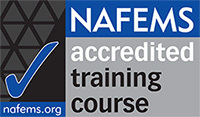What are the differences between various differencing and meshing schemes?
What are the basics of turbulence, heat transfer, and FSI modelling?
What are errors and uncertainties in CFD and how do you reduce them?
Get the answers to these questions and more with this industry-leading, code-independent e-learning course.
Introduction to Practical CFD
New Revised Course for 2025
This course offers attendees fundamental knowledge on using CFD in real-life engineering applications. Adopting a straightforward and moderately technical approach, it outlines the CFD process and explains the advantages and challenges of employing CFD analysis in the simulation of complex flow phenomena, as well as the integration of CFD into the design process. Additionally, the course highlights best practices to minimize errors and uncertainties in CFD studies. While key governing equations will be introduced for illustrative purposes, they will not be explored in detail. The course strives to remain CFD software neutral, though examples from prominent and widely used software packages will be incorporated to enhance learning.
What questions will the course answer?
- What is the role of CFD, and what is the CFD process?
- What are the differences between various differencing schemes?
- What are the challenges faced in the simulation of flows with turbulence, heat transfer, or fluid-structure interaction?
- Are there different simulation strategies for different flow regimes?
- How do you assess the accuracy of your numerical solutions?
- What are the best practices in CFD simulations?
Who should attend?
- engineers who are new to CFD simulation
- engineers who need a refresher on CFD
- managers working with CFD simulation engineers
The course is completely code independent.
This is a 6-session online training course, with each session lasting for approximately 2/2.5 hours, depending on homework submissions, questions & discussions.
You can attend the sessions live, and/or stream on demand. When you register you will get access to a dedicated course forum where you can contact the tutor with questions, submit homework, download pdfs of course notes and access all session recordings. To get the most out of the course, participation in forum discussions is encouraged.
Questions? Contact us on e-learning@nafems.org
Course Program
Note: This is a six week course. Each session represents one 2 hour* session each week. The length of each session can vary, depending on Q&A, homework responses, and other contributing factors.
Part 1 - Session 1
- CFD Intro and Process Overview
- Governing Principles
- Simplified Model
- Order of Accuracy
Part 1 - Session 2
- CFD Role
- Differencing Formulation
- Major Formulation
- Model & Physics Simplifications
Part 1 - Session 3
- Details of CFD Process
- Overview of Major Challenges in CFD
Part 2 - Session 1
- Flow Classifications
- Turbulence
Part 2 – Session 2
- Pressure-Related Phenomena
- Fluid-Structure Interaction
Part 2 – Session 3
- Multiphase
- Heat Transfer
- CFD Accuracy & Best Practices






